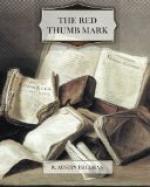“In the second place, on measuring the print with a micrometer, I found that it did not agree in dimensions with a genuine thumb-print of Reuben Hornby. It was appreciably larger. I photographed the print with the micrometer in contact and on comparing this with a genuine thumb-print, also photographed with the same micrometer in contact, I found that the suspected print was larger by the fortieth of an inch, from one given point on the ridge-pattern to another given point. I have here enlargements of the two photographs in which the disagreement in size is clearly shown by the lines of the micrometer. I have also the micrometer itself and a portable microscope, if the Court wishes to verify the photographs.”
“Thank you,” said the judge, with a bland smile; “we will accept your sworn testimony unless the learned counsel for the prosecution demands verification.”
He received the photographs which Thorndyke handed up and, having examined them with close attention, passed them on to the jury.
“The third fact,” resumed Thorndyke, “is of much more importance, since it not only proves the print to be a forgery, but also furnishes a very distinct clue to the origin of the forgery, and so to the identity of the forger.” (Here the court became hushed until the silence was so profound that the ticking of the clock seemed a sensible interruption. I glanced at Walter, who sat motionless and rigid at the end of the bench, and perceived that a horrible pallor had spread over his face, while his forehead was covered with beads of perspiration.) “On looking at the print closely, I noticed at one part a minute white mark or space. It was of the shape of a capital S and had evidently been produced by a defect in the paper—a loose fibre which had stuck to the thumb and been detached by it from the paper, leaving a blank space where it had been. But, on examining the paper under a low power of the microscope, I found the surface to be perfect and intact. No loose fibre had been detached from it, for if it had, the broken end or, at least, the groove in which it had lain, would have been visible. The inference seemed to be that the loose fibre had existed, not in the paper which was found in the safe, but in the paper on which the original thumb-mark had been made. Now, as far as I knew, there was only one undoubted thumb-print of Reuben Hornby’s in existence—the one in the ‘Thumbograph.’ At my request, the ‘Thumbograph’ was brought to my chambers by Mrs. Hornby, and, on examining the print of Reuben Hornby’s left thumb, I perceived on it a minute, S-shaped white space occupying a similar position to that in the red thumb-mark; and when I looked at it through a powerful lens, I could clearly see the little groove in the paper in which the fibre had lain and from which it had been lifted by the inked thumb. I subsequently made a systematic comparison of the marks in the two thumb-prints; I found that the dimensions of the mark were proportionally the




